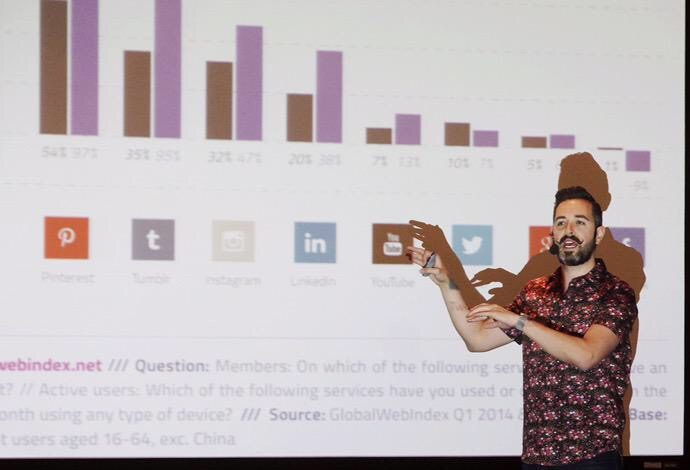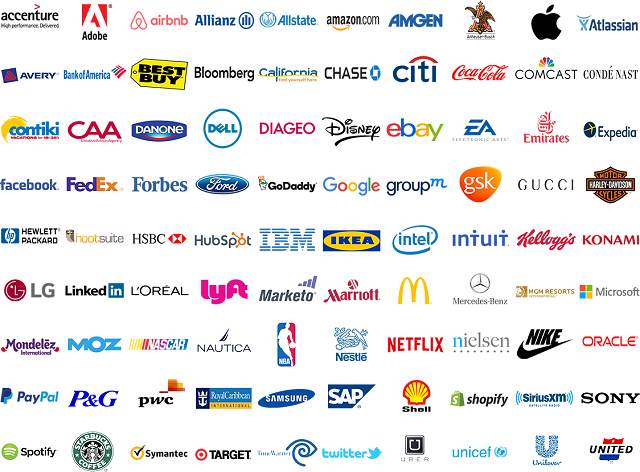Posts Tagged "Mobile optimization"
Articles
- Best Marketing Conference Sponsorship
- What Does it Mean to Be an Exhibitor at a Conference?
- What Is the Biggest Social Media Conference?
- What Is an Innovation Conference?
- What Is a Typical B2B Event?
- What Are the Cloud Technology Events in 2025?
- Marketing Event Volunteer Opportunities: A Comprehensive Guide
- Digital Marketing Event Volunteer Opportunities Near Me
- What Does a Volunteer Do at a Conference?
- Is DigiMarCon Worth It?
- Is DigiMarCon Good?
- What is the Biggest Marketing Forum?
- What are Digital Marketing Conferences?
- Marketing Conference Exhibiting: Your Guide to Success
- Digital Summit Comparison: A Closer Look at DigiMarCon
- Digital Marketing Conference
- Digital Marketing Events: Your Guide to Success in 2025
- Marketing Conferences: Unlocking Your Business Potential in 2025
- What Is The Future of Digital Marketing in 2030?
- B2B Event Marketing Strategy: Unlocking Success For Your Business
- Why B2B Event Marketing?
- What Should a B2B Marketing Strategy Include?
- Top Marketing Conferences for 2025
- What Is the Future of Marketing in 2025?
Digital Marketing Conferences
- NORTH AMERICA
- DigiMarCon Cruise
(New Orleans, LA, USA) - DigiMarCon West
(Los Angeles, CA, USA) - DigiMarCon Northwest
(Seattle, WA, USA) - DigiMarCon Canada West
(Vancouver, BC, USA) - DigiMarCon Canada
(Toronto, ON, Canada) - DigiMarCon Canada East
(Montreal, QC, Canada) - DigiMarCon Florida
(Orlando, FL, USA) - DigiMarCon Gulf Coast
(Houston, TX, USA) - DigiMarCon Southern California
(San Diego, CA, USA) - DigiMarCon Midwest
(Chicago, IL, USA) - DigiMarCon Mid-South
(Nashville, TN, USA) - DigiMarCon Great Lakes
(Detroit, MI, USA) - DigiMarCon North
(Minneapolis, MN, USA) - DigiMarCon Central
(Kansas City, MO, USA) - DigiMarCon Texas
(Dallas, TX, USA) - DigiMarCon New England
(Boston, MA, USA) - DigiMarCon Mid-Atlantic
(Philadelphia, PA, USA) - DigiMarCon South Florida
(Miami, FL, USA) - DigiMarCon Southeast
(Atlanta, GA, USA) - DigiMarCon Central Florida
(Tampa, FL, USA) - DigiMarCon East
(New York, NY, USA) - DigiMarCon South Atlantic
(Charlotte, NC, USA) - DigiMarCon America
(Washington, D.C. USA) - DigiMarCon Northern California
(San Francisco, CA, USA) - DigiMarCon Rocky Mountains
(Denver, CO, USA) - DigiMarCon South
(San Antonio, TX, USA) - DigiMarCon Silicon Valley
(San Jose, CA, USA) - DigiMarCon Orange County
(Anaheim, CA, USA) - DigiMarCon Southwest
(Phoenix, AZ, USA) - DigiMarCon World
(Las Vegas, NV, USA)
- DigiMarCon Cruise
- LATIN AMERICA
- EUROPE
- MIDDLE EAST
- AFRICA
- ASIA PACIFIC
- DigiMarCon Hawaii & Pacific
(Honolulu, HI, USA) - DigiMarCon Asia & Japan
(Tokyo, Japan) - DigiMarCon New Zealand
(Auckland, New Zealand) - DigiMarCon Australia
(Sydney, Australia) - DigiMarCon Oceania
(Melbourne, Australia) - DigiMarCon Southeast Asia
(Singapore) - DigiMarCon India
(New Delhi, India) - DigiMarCon North Asia & China
(Shanghai, China)
- DigiMarCon Hawaii & Pacific
- VIRTUAL
Digital Marketing Blog
- Unlock Website Traffic Growth: 10 Proven Hacks to Try September 16, 2025
- Sponsorship Opportunities at DigiMarCon 2025 – Join Us Now September 16, 2025
- Sponsorship Opportunities at DigiMarCon 2025 – Join Us Now September 16, 2025
- Mastering Video Marketing: Essential Tips to Boost Your Business September 15, 2025

































Mobile Marketing: Strategies for Success
In today’s digital world, reaching customers on-the-go is key for businesses to keep up. So, effective mobile marketing strategies are now a top focus.
Most people use their smartphones to find information. Businesses need to change their marketing to meet this new trend. This article will look at the best mobile marketing strategies for success in the fast-changing digital world.
Key Takeaways
The Current State of Mobile Marketing in 2023
The world of mobile marketing is changing fast in 2023. New tech and how people act are leading the way. Businesses must update their marketing to reach people on their phones.
Key Statistics and Market Trends
Mobile devices are taking over the digital world. Mobile ads are getting more common, with lots of money spent on them. More people are shopping on their phones, too. Here are some important numbers:
Why Mobile-First Is No Longer Optional
Nowadays, focusing on mobile is a must, not just a choice. Most people use their phones to find info. So, businesses need to focus on mobile marketing to keep up.
A mobile-first approach helps companies reach their audience better. It makes the user experience better and boosts sales through mobile advertising. This way, businesses can lead the mobile market.
Understanding Mobile Consumer Behavior
It’s key for businesses to get how people use mobile devices today. With mobiles being a big part of our lives, marketers need to know how we use them. This helps them make good plans.
Mobile Usage Patterns in the United States
In the US, people are using mobiles more than ever. Americans spend about 3 hours and 45 minutes on their mobiles every day. They use them for social media, games, and shopping online. Marketers should know this to make their ads better.
The Mobile Customer Journey
The mobile customer journey has many steps, from first seeing a product to after buying it. Personalization is very important here. People want experiences that fit their likes and habits. Knowing the journey helps businesses make customers happier and more loyal.
Micro-Moments and Purchase Decisions
Micro-moments are short times when people decide to buy something. These moments, like wanting to know something or buy something, are key. Marketers can reach people at these times to make their ads more effective.
By understanding how people use mobiles, businesses can make plans that really speak to their audience. This leads to more people engaging and buying from them.
Fundamental Mobile Marketing Strategies
In today’s world, having a strong mobile marketing plan is key for businesses to keep up. People use their phones for everything from info to shopping. So, companies need to adjust their marketing to reach their audience effectively.
Creating a Mobile-First Content Strategy
A mobile-first content plan means making content easy to read on small screens. This means short messages, small images, and websites that work on all devices. By focusing on mobile, businesses can make their content better and get more people involved.
Cross-Channel Integration Techniques
Cross-channel integration means working together on different platforms for a smooth experience. This includes linking social media, email, and in-app messages. It helps businesses keep customers engaged and loyal.
Personalization in Mobile Experiences
Personalization is essential for good mobile marketing. Tailoring content and offers to each user boosts conversion rates. This is done by using data on what users like and do.
Data Collection Methods
Good personalization starts with the right data. This data comes from user sign-ups, cookies, and tracking app and website behavior. With this data, businesses can make targeted ads.
Implementation Approaches
To personalize, use the data to make unique experiences. This means personalized suggestions, special deals, and custom content. These steps help improve user experience and increase sales.
Mobile App Marketing Essentials
Mobile apps are everywhere in our digital world. For businesses, marketing these apps is key to growing. A good plan is needed to attract and keep users in a crowded market.
App Store Optimization Techniques
App Store Optimization (ASO) is vital for mobile app marketing. It makes an app’s listing on stores more visible and appealing. This includes using the right keywords, creating catchy icons, and getting good reviews.
User Acquisition Campaigns
Getting users is crucial for mobile app marketing. Campaigns use social media, influencer partnerships, and targeted ads. Data helps improve these efforts to reach the right people and boost downloads.
Retention and Engagement Tactics
Keeping users is as important as getting them. Tactics like personalization and updates keep users interested. This makes the app more enjoyable and keeps users coming back.
Push Notification Strategies
Push notifications are great for bringing users back. They should be timely, relevant, and personal. Avoiding too many notifications keeps users happy.
In-App Messaging Best Practices
In-app messaging talks directly to users when they’re using the app. It should be clear, relevant, and useful. This approach boosts engagement and helps with sales.
SMS Marketing in the Modern Mobile Landscape
In today’s world, SMS marketing is key for businesses to reach their audience. Almost everyone has a mobile phone, making SMS a direct way to connect with customers.
Building Compliant SMS Campaigns
Businesses must follow rules like the TCPA in the US to succeed in SMS marketing. They need to get clear consent from people before sending messages. Clear opt-in processes and easy opt-out mechanisms are vital for staying compliant and gaining customer trust.
It’s also important to be open about what messages customers will get and how often. This builds trust and keeps customers happy.
SMS Automation and Personalization
SMS automation lets businesses send messages at the right time without manual effort. By using customer data, they can make personalized SMS campaigns. These messages address customers by name and talk about their specific interactions.
Automation also helps send messages based on what customers do, like reminders for abandoned carts or appointments.
Timing and Frequency Considerations
The right time and frequency for SMS messages matter a lot. Businesses should think about the time of day and day of the week to get better results. This helps increase open rates and engagement.
Measuring SMS Campaign Performance
To see how well SMS marketing works, businesses should look at important metrics. These include delivery rates, open rates, and conversion rates. By analyzing these, businesses can make their SMS strategies better and improve future campaigns.
Location-Based Marketing Strategies
The rise of mobile devices has made location-based marketing key for businesses. It helps them connect with their audience in real-time. By using location data, companies can send targeted messages, improving engagement and sales.
Geofencing Implementation Guide
Geofencing is a marketing technique that uses virtual boundaries around specific areas. Businesses should pick key locations for their audience, like near competitors or busy spots. By setting up geofences, they can send messages or offers when customers are nearby.
Beacon Technology Applications
Beacon technology sends messages to smartphones near small Bluetooth devices. It’s great for retail, making shopping better and boosting in-store sales. Businesses can send personalized offers based on a customer’s location.
Geo-Targeted Ad Campaigns
Geo-targeted ads aim ads at users based on their location. This can be through social media, search engines, or mobile apps. Targeting ads to specific areas makes messages more relevant and increases the chance of reaching the right audience.
Privacy Considerations
Businesses must think about privacy when using location-based marketing. They need to get clear consent for location data and follow laws like GDPR and CCPA.
Performance Metrics
To see how well location-based marketing works, businesses should track important metrics. These include click-through rates, conversion rates, and return on ad spend (ROAS). By analyzing these, they can improve their strategies and campaigns.
Mobile Website Optimization for Conversion
Mobile devices now rule the internet. Making sure your website works well on them is essential. A mobile-friendly site is key for a great user experience and more sales.
Mobile-First Design Principles
Designing for small screens first is called mobile-first. It makes content and navigation simpler. Use responsive design, easy menus, and clear calls-to-action.
Page Speed Optimization Techniques
Fast page loading is crucial for mobile users and search rankings. Improve speed by optimizing images, using browser caching, and reducing CSS and JavaScript. Google PageSpeed Insights can spot areas for betterment.
Mobile SEO Best Practices
Mobile SEO is important for mobile visibility. Use themes that work well on mobile, optimize for voice search, and make content easy to read on small screens.
Technical SEO for Mobile
Technical SEO for mobile means optimizing site structure and coding for mobile. Use schema markup, optimize images, and ensure the site is secure (HTTPS).
Content Optimization for Mobile Search
Optimize content for mobile search by making it easy to read on small screens. Use short paragraphs, optimize headings, and match content to mobile user needs.
By following these tips, businesses can boost their mobile site’s performance. This leads to a better user experience and more sales.
Effective Mobile Advertising Formats
Mobile devices are now a big part of our lives. This makes mobile ads key for any marketing plan. With many ad formats out there, picking the right ones is important for good results.
In-App Advertising Strategies
In-app ads are a great way to connect with people. They use in-app ad formats like banners and videos. This way, ads fit right into the apps people love.
Social Media Mobile Ad Formats
Social media is a big deal for mobile ads. It has many ad types, like sponsored content and carousel ads. This lets businesses try different ads to see what works best.
Video and Interactive Mobile Ads
Video and interactive ads are getting more attention. They make ads more fun and engaging. Adding interactive elements like games can make ads stand out.
When checking how ads do, look at things like clicks and sales. This helps businesses see which ads work best. They can then use their money better.
Budget Allocation Guidelines
To get the most from mobile ads, spend more on ads that do well. Start with more budget for top ads. Keep trying new ads to see if they can do better.
Measuring and Analyzing Mobile Marketing Success
Mobile marketing is always changing, and it’s key for businesses to measure its success. Marketers need to focus on important metrics and use the right tools to analyze their efforts.
Essential Mobile Marketing Metrics
Businesses should track app downloads, in-app engagement, and conversion rates to see how well their campaigns are doing. They should also look at customer lifetime value (CLV) and return on ad spend (ROAS). These metrics help marketers understand what’s working and make smart choices.
Attribution Models for Mobile Campaigns
Attribution modeling is vital in mobile marketing. It shows how different parts of a campaign lead to sales. There are models like last-click, first-click, and multi-touch attribution. Choosing the right one helps businesses see the real impact of their mobile marketing.
Analytics Tools and Platforms
Many analytics tools and platforms help marketers measure their mobile marketing. Google Analytics, Firebase, and Adjust are popular choices. They offer insights into how users behave and how well campaigns perform.
Setting Up Proper Tracking
To measure accurately, businesses need to set up tracking correctly. This means adding tracking codes, setting up conversion events, and choosing the right attribution models.
Reporting and Dashboard Creation
Creating reports and dashboards is crucial for analysis and decision-making. By showing key metrics and data, marketers can spot areas for improvement. This helps them fine-tune their mobile marketing plans.
Emerging Trends Shaping the Future of Mobile Marketing
Several key trends are set to change the mobile marketing world. The mobile marketing field is on the verge of a big change. This is thanks to new tech and how people behave.
Augmented Reality Applications
Augmented Reality (AR) is getting more popular in mobile marketing. It lets brands create cool experiences for customers. For example, AR can let customers see how products look on them without trying them on.
Voice Search Optimization
Voice assistants like Siri and Google Assistant are changing how we search. Mobile marketers must make their content easy to find with voice search. They use natural language and specific keywords to do this.
5G Impact on Mobile Experiences
The arrival of 5G networks will change mobile experiences a lot. It will make data speeds faster and lower latency. This means businesses can offer better experiences, like high-definition video and immersive AR.
AI and Machine Learning Integration
AI and machine learning are being used more in mobile marketing. They help make customer experiences more personal and improve marketing campaigns. AI tools help businesses understand what customers like and want.
Privacy-First Mobile Marketing
With more people worried about their data, mobile marketing must focus on privacy. Businesses need to be open about how they use data. They must also protect customer information.
By keeping up with these trends, businesses can succeed in the changing mobile marketing world.
Conclusion: Building an Integrated Mobile Marketing Strategy
Creating a solid mobile marketing strategy is key for businesses to keep up in today’s digital world. It helps make sure customers have a smooth experience everywhere they interact with your brand.
A good mobile marketing plan means knowing what your customers want, using the best marketing tools, and checking how well your campaigns work. This article talked about making content just for mobile, using SMS, and making your website work well on phones.
To make a strong marketing plan, think about how mobile fits into your bigger goals. This way, you can get more people involved, increase sales, and grow your revenue. Keeping up with new mobile trends and tech is also vital for lasting success.
By using these strategies and keeping your focus on your audience, you can build a powerful mobile marketing plan. This plan will help you achieve your business goals and get real results.
FAQ
What is the importance of mobile marketing in today’s digital landscape?
Mobile marketing is key today because it lets businesses connect with people on their phones. Most people use phones to find info, so mobile marketing helps businesses reach them quickly and personally.
How can businesses optimize their mobile website for conversion?
To boost mobile website conversions, businesses should focus on design and speed. They should make sure their site works well on phones, loads fast, and is easy to use. This makes for a better user experience.
What are the benefits of using SMS marketing in mobile marketing campaigns?
SMS marketing is great because it gets high open rates and boosts engagement. It also helps in converting more customers. By creating smart SMS campaigns, businesses can reach and engage their audience well.
How can businesses leverage location-based marketing to reach their target audience?
To use location-based marketing, businesses can set up geofences and use beacons. They can also target ads based on where people are. This helps attract more customers and increase sales.
What are the key metrics to measure the success of mobile marketing campaigns?
Important metrics for mobile marketing success include click-through rates and conversion rates. Businesses can use analytics to understand how well their campaigns are doing. This helps them make better decisions.
How can businesses stay ahead of the curve in mobile marketing?
To stay ahead, businesses should watch for new trends like augmented reality and voice search. They should also use AI and focus on privacy. This keeps them competitive in the fast-changing mobile marketing world.
Boost Your Rankings with On-Page Optimization
In today’s digital world, having a well-optimized website is key for search engine rankings. On-page optimization is a vital part of SEO. It helps search engines understand your website’s structure and content.
By improving your website’s on-page elements, you can boost your search engine rankings. This leads to more traffic and better online visibility. It’s all about making your website more search engine-friendly by following SEO best practices.
Key Takeaways
What is On-Page Optimization?
To boost your website’s search engine rankings, knowing about on-page optimization is key. It’s the process of making each web page better for search engines.
It means making your webpage friendly for search engines. This includes using keywords, optimizing content, and meta tags.
Definition and Importance
On-page optimization is vital for getting more people to see your website. By tweaking your webpage, you make it more appealing to search engines.
Key benefits include better search rankings, more visibility online, and a better user experience.
Key Components
The main parts of on-page optimization are:
Knowing these elements is essential for better search rankings and more website visitors.
Understanding Search Engines
Knowing how search engines work is key for any SEO plan. Google, Bing, and Yahoo are the main tools for finding online info. Their results depend on complex algorithms that keep getting better.
To see why SEO matters, it helps to understand search engines. They do three main things: crawling, indexing, and ranking. Crawling is finding new web content. Indexing is organizing that content. Ranking sorts content by relevance and quality for users.
How Search Engines Work
Search engines use crawlers or spiders to scan the web for new content. This can be web pages, articles, videos, or images. After finding content, search engines index it, looking at its context, keywords, and quality.
Crawling and indexing are key. They decide what content shows up in search results. Without them, a site might not be found, even if it’s great.
The Role of Algorithms
Algorithms are crucial for ranking content. They look at many things like keywords, content quality, and user experience. Knowing about algorithms is important for good SEO.
By making high-quality, user-friendly content and using the right keywords, you can boost your site’s ranking. This increases your online visibility and brings more visitors to your site.
Keeping up with SEO trends and best practices is essential. It helps keep and improve your search rankings over time.
Keywords are key in on-page SEO, forming the base of all optimization. By picking the right keywords, businesses can boost their site’s search rankings. This leads to more targeted traffic.
Choosing the Right Keywords
Choosing the right keywords means doing deep keyword research. You need to find terms your audience uses to find content like yours. Tools like Google Keyword Planner, Ahrefs, and SEMrush help by showing search volume, competition, and related keywords.
Keyword Placement Tips
After picking your keywords, place them well in your content. Good keyword placement makes your site more visible and relevant in search results.
By optimizing content with strategic keywords, businesses can boost their on-page SEO. The goal is to mix keyword use with quality, engaging content. This way, you connect with your audience.
Content Quality: Engaging and Relevant
To boost your website’s search engine rankings, focus on developing a content strategy that prioritizes user value. High-quality, engaging, and relevant content is essential for on-page optimization. It directly impacts how search engines perceive and rank your website.
Search engines prioritize content that provides value to users. It’s crucial to understand what constitutes high-quality content. By focusing on content optimization, you can improve your website’s visibility and drive more traffic.
The Importance of High-Quality Content
High-quality content engages and informs the target audience. To achieve this, focus on creating content that is:
By incorporating these characteristics, you can create content that resonates with your audience. It also adheres to SEO best practices.
How to Create Engaging Content
Creating engaging content requires a strategic approach. Here are some tips to help you get started:
By implementing these strategies, you can improve your website optimization efforts. This will drive more traffic to your site.
Title Tags and Meta Descriptions
Title tags and meta descriptions are key in on-page SEO. They help your website rank better in search engines. These elements tell search engines what your webpage is about.
Crafting Effective Title Tags
Making good title tags means creating titles that are descriptive and include your main keyword. Here are some tips:
By following these tips, you can make title tags that boost your search rankings and get more clicks.
Writing Compelling Meta Descriptions
Meta descriptions are also crucial. They give users a quick summary of your webpage in search results. To write great meta descriptions:
A good meta description can increase your webpage’s click-through rate. This means more people will visit your site.
Optimizing your title tags and meta descriptions can make your website more visible. This improves your search engine rankings and drives more traffic to your site.
URL Structure: The URL Best Practices
Making the perfect URL is more than just a technical task. It’s an art that makes your site better for users and search engines. A good URL structure is key for on-page optimization. It helps search engines understand your website’s content and layout.
Optimizing Your URLs means creating URLs that are descriptive and include keywords. They should clearly show what your webpage is about. This boosts your search engine rankings and makes your site easier to use.
Optimizing Your URLs
To make your URLs better, follow these tips:
The Importance of URL Readability
URL readability is key for both users and search engines. A clear URL is more likely to get clicked and shared. This boosts your site’s visibility and engagement.
Best practices for URL readability include using simple language and avoiding extra parameters. Make sure your URL clearly shows what the page is about. By focusing on readability, you can improve your site’s user experience and search rankings.
In summary, optimizing your URL structure is vital for on-page SEO. It greatly affects your site’s visibility and user experience. By following best practices for URL optimization and readability, you can boost your search engine rankings and attract more visitors.
Header Tags: Organizing Your Content
Header tags are key to making your content easy to read and SEO-friendly. They help search engines understand and rank your content better.
Using H1, H2, and H3 Tags
Using H1, H2, and H3 tags correctly is important. The H1 tag is for the main title. H2 tags are for subheadings, and H3 tags for even more subheadings under H2.
This structure helps search engines get your content’s context and relevance. For example, your main keyword can be in the H1 tag. H2 and H3 tags can have related keywords, making your content more relevant.
Best Practices for Header Tag Structure
To get the most out of header tags, follow some best practices. First, make sure your header tags are descriptive and keyword-rich. This means using the right keywords in your headers to tell search engines what your content is about.
Second, keep your header tags in a logical order. Don’t skip levels (like going from H1 to H3). Instead, use a sequence like H1 > H2 > H3 to make your structure clear.
By following these best practices and using header tags well, you can make your content easier to read. This improves user experience and boosts your SEO efforts.
Image Optimization: Visual Appeal and Speed
Images are more than just pretty pictures on your website. They play a big role in how fast your site loads and how engaging it is for users. Making your images better is key to improving your site’s look and speed.
Using Alt Tags Effectively
Alt tags give a text description of images, which is vital for search engine optimization (SEO). By adding the right keywords to your alt tags, you can make your site more visible in search results.
Compressing Images for Faster Load Times
Big image files can slow down your website, hurting user experience and search rankings. Compressing images makes them smaller without losing quality, making your site load faster.
By using these image optimization tips, you can make your website look better, load faster, and rank higher in search engines. Good image optimization is a big part of a solid on-page SEO plan.
Internal Linking: Connecting Your Content
A strong internal linking strategy boosts your website’s visibility and user navigation. It’s a key part of on-page optimization. Internal linking creates a network of links between your website’s pages. This helps both users and search engines understand your content’s hierarchy and relevance.
Building a Strong Internal Link Structure
To create a solid internal link structure, first identify your key pages. These are usually your cornerstone content or service/product pages. Then, set up a logical link hierarchy that guides users through your site. Make sure each page is just a few clicks away from the homepage or main category pages.
Use descriptive and keyword-rich anchor text for your internal links. This helps search engines grasp the linked page’s context. For example, instead of “Click here,” use specific phrases like “Learn more about on-page SEO best practices.”
Best Practices for Internal Links
Following best practices for internal linking boosts your website’s SEO and user experience. Here are some key strategies:
By following these guidelines and integrating a thoughtful internal linking strategy, you can enhance your website’s SEO performance. It also makes it easier for users to find what they’re looking for.
Mobile Optimization: Catering to Mobile Users
Most people use the internet on their phones. So, making your website mobile-friendly is key for SEO. A good mobile site makes your content easy to see and use on phones, helping your ranking.
Creating a mobile-responsive design is important. It means your site looks great on all devices. It changes size and layout to fit any screen.
The Importance of Mobile-Responsive Design
A mobile-responsive design is vital. It makes your site easy to use on any device. It also helps your site rank better in search engines. Plus, it makes it easier for people to find what they need on their phones.
Here are some benefits of a mobile-responsive design:
Tools for Testing Mobile Optimization
To check if your site is mobile-friendly, use tools like Google’s Mobile-Friendly Test. It checks how well your site works on phones and suggests ways to improve.
Other tools for checking mobile optimization include:
By making your site mobile-friendly and using the right tools, you can boost your rankings. You’ll also make your site easier to use and get more visitors.
Page Speed: A Critical Ranking Factor
Page speed is now a key factor in how well your website ranks. A slow site can cause people to leave quickly, leading to lower rankings. This is a big problem in today’s fast-paced online world.
A website that loads fast is better for users and search engines. It makes your site more engaging and helps it rank higher. This is why page speed is so important for on-page SEO.
Tools to Analyze Page Speed
To make your site load faster, you need to check its speed first. There are many tools to help you do this, including:
These tools give you detailed reports on your site’s speed. They show you what needs work and suggest ways to improve.
Tips for Improving Load Times
To speed up your site, you need to tackle it from different angles. Here are some tips to help you:
By using these tips and keeping an eye on your site’s speed, you can improve your rankings. This will make your site more user-friendly and help you get more visitors.
User Experience: Enhancing Visitor Engagement
Creating a smooth and engaging experience for users is key in on-page optimization. By focusing on user experience, businesses can boost their website’s search engine rankings. This also drives more conversions.
The role of UX in on-page SEO is to understand user behavior and preferences. This means making your website easy to use. Use clear navigation, provide top-notch content, and make sure your site works well on mobile devices.
Key Strategies for Better UX
To make your site more engaging, consider these strategies: make your website load faster, use easy navigation, and ensure it works well on mobile. These steps can enhance your site’s user experience and improve its on-page SEO.
Also, optimizing your content is vital for a better user experience. By creating high-quality, relevant, and engaging content, you meet your audience’s needs. This can also help your website rank higher in search engines.
What is on-page optimization, and why is it important?
On-page optimization makes your web pages better for search engines. It helps your site rank higher, get more visitors, and be seen more online.
How do I choose the right keywords for my website?
Pick keywords that match what people search for when they look for content like yours. Use tools like Google Keyword Planner or Ahrefs to find good keywords.
What is the ideal length for a meta description?
A meta description should be 150-160 characters long. This lets you give a quick summary of your page’s content and encourage clicks.
How can I improve my website’s page speed?
Speed up your site by optimizing images, minifying code, and using browser caching. A content delivery network (CDN) also helps. Google’s PageSpeed Insights can show you how to get faster.
What is the importance of mobile optimization for my website?
Mobile optimization is key for mobile users and better search rankings. A site that works well on all devices is essential.
How often should I update my website’s content?
Update your content often to keep it fresh. How often depends on your field, audience, and content plan. Try to update at least once a month to boost rankings.
What is the role of internal linking in on-page optimization?
Internal linking connects your content and helps search engines understand your site’s structure. It makes your site easier to navigate and understand.
How can I optimize my images for search engines?
Optimize images with descriptive alt tags, compress them to save space, and use relevant file names. This helps search engines get your image content and speeds up your site.